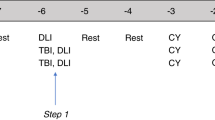Abstract
Allogeneic hematopoietic SCT (HSCT) from an HLA-identical sibling donor is the recommended upfront therapeutic option for young patients with SAA. The outcome of allogeneic sibling HSCT has remarkably improved during the last decade as a function of improvement in transplantation supportive care. However, there is still much debate concerning the upper age limit for sibling HSCT in SAA, particularly in patients who are refractory to at least one immunosuppressive course. Recent studies suggest that fludarabine-based conditioning may improve HSCT outcome in older patients with SAA. This review discusses available data about the use of fludarabine-based conditioning in transplantation of older patients with SAA. More definitive conclusions are needed from larger studies before the wide adoption of fludarabine-based conditioning as an alternative to the standard CY and ATG-based conditioning.
This is a preview of subscription content, access via your institution
Access options
Subscribe to this journal
Receive 12 print issues and online access
$259.00 per year
only $21.58 per issue
Buy this article
- Purchase on Springer Link
- Instant access to full article PDF
Prices may be subject to local taxes which are calculated during checkout
Similar content being viewed by others
References
Doney K, Leisenring W, Storb R, Appelbaum FR . Primary treatment of acquired aplastic anemia: outcomes with bone marrow transplantation and immunosuppressive therapy. Seattle Bone Marrow Transplant Team. Ann Intern Med 1997; 126: 107–115.
Bacigalupo A, Hows J, Gluckman E, Nissen C, Marsh J, Van Lint MT et al. Bone marrow transplantation (BMT) versus immunosuppression for the treatment of severe aplastic anaemia (SAA): a report of the EBMT SAA working party. Br J Haematol 1988; 70: 177–182.
Passweg JR, Socié G, Hinterberger W, Bacigalupo A, Biggs JC, Camitta BM et al. Bone marrow transplantation for severe aplastic anemia: has outcome improved? Blood 1997; 90: 858–864.
Bacigalupo A, Brand R, Oneto R, Bruno B, Socié G, Passweg J et al. Treatment of acquired severe aplastic anemia: bone marrow transplantation compared with immunosuppressive therapy--The European Group for Blood and Marrow Transplantation experience. Semin Hematol 2000; 37: 69–80.
Ades L, Mary JY, Robin M, Ferry C, Porcher R, Esperou H et al. Long-term outcome after bone marrow transplantation for severe aplastic anemia. Blood 2004; 103: 2490–2497.
Gupta V, Eapen M, Brazauskas R, Carreras J, Aljurf M, Gale RP et al. Impact of age on outcomes after bone marrow transplantation for acquired aplastic anemia using HLA-matched sibling donors. Haematologica 2010; 95: 2119–2125.
Sangiolo D, Storb R, Deeg HJ, Flowers ME, Martin PJ, Sandmaier BM et al. Outcome of allogeneic hematopoietic cell transplantation from HLA-identical siblings for severe aplastic anemia in patients over 40 years of age. Biol Blood Marrow Transplant 2010; 16: 1411–1418.
Ringdén O, Remberger M, Svenberg P, Svahn BM, Dahllöf G, Gustafsson B et al. Fludarabine-based disease-specific conditioning or conventional myeloablative conditioning in hematopoietic stem cell transplantation for treatment of non-malignant diseases. Bone Marrow Transplant 2007; 39: 383–388.
Al-Zahrani H, Nassar A, Al-Mohareb F, Al-Sharif F, Mohamed S, Al-Anazi K et al. Fludarabine-based conditioning chemotherapy for allogeneic hematopoietic stem cell transplantation in acquired severe aplastic anemia. Biol Blood Marrow Transplant 2011; 17: 717–722.
Srinivasan R, Takahashi Y, McCoy JP, Espinoza-Delgado I, Dorrance C, Igarashi T et al. Overcoming graft rejection in heavily transfused and allo-immunised patients with bone marrow failure syndromes using fludarabine-based haematopoietic cell transplantation. Br J Haematol 2006; 133: 305–314.
Resnick IB, Aker M, Shapira MY, Tsirigotis PD, Bitan M, Abdul-Hai A et al. Allogeneic stem cell transplantation for severe acquired aplastic anaemia using a fludarabine-based preparative regimen. Br J Haematol 2006; 133: 649–654.
Gómez-Almaguer D, Vela-Ojeda J, Jaime-Pérez JC, Gutiérrez-Aguirre CH, Cantú-Rodríguez OG, Sobrevilla-Calvo P et al. Allografting in patients with severe, refractory aplastic anemia using peripheral blood stem cells and a fludarabine-based conditioning regimen: the Mexican experience. Am J Hematol 2006; 81: 157–161.
George B, Mathews V, Viswabandya A, Kavitha ML, Srivastava A, Chandy M . Fludarabine and cyclophosphamide based reduced intensity conditioning (RIC) regimens reduce rejection and improve outcome in Indian patients undergoing allogeneic stem cell transplantation for severe aplastic anemia. Bone Marrow Transplant 2007; 40: 13–18.
Maury S, Bacigalupo A, Anderlini P, Aljurf M, Marsh J, Socié G et al. Severe Aplastic Anemia Working Party, European Group for Blood and Marrow Transplantation (EBMT-SAAWP). Improved outcome of patients older than 30 years receiving HLA-identical sibling hematopoietic stem cell transplantation for severe acquired aplastic anemia using fludarabine-based conditioning: a comparison with conventional conditioning regimen. Haematologica 2009; 94: 1312–1315.
Marsh JC, Gupta V, Lim Z, Ho AY, Ireland RM, Hayden J et al. Alemtuzumab with fludarabine and cyclophosphamide reduces chronic graft-versus-host disease after allogeneic stem cell transplantation for acquired aplastic anemia. Blood 2011; 118: 2351–2357.
Ho AY, Pagliuca A, Kenyon M, Parker JE, Mijovic A, Devereux S et al. Reduced-intensity allogeneic hematopoietic stem cell transplantation for myelodysplastic syndrome and acute myeloid leukemia with multilineage dysplasia using fludarabine, busulphan, and alemtuzumab (FBC) conditioning. Blood 2004; 104: 1616–1623.
Lim Z, Brand R, Martino R, van Biezen A, Finke J, Bacigalupo A et al. Allogeneic hematopoietic stem-cell transplantation for patients 50 years or older with myelodysplastic syndromes or secondary acute myeloid leukemia. J Clin Oncol 2010; 28: 405–411.
McClune BL, Weisdorf DJ, Pedersen TL, Tunes da Silva G, Tallman MS, Sierra J et al. Effect of age on outcome of reduced-intensity hematopoietic cell transplantation for older patients with acute myeloid leukemia in first complete remission or with myelodysplastic syndrome. J Clin Oncol 2010; 28: 1878–1887.
Author information
Authors and Affiliations
Corresponding author
Ethics declarations
Competing interests
The authors declare no conflict of interest
Rights and permissions
About this article
Cite this article
Maury, S., Aljurf, M. Management of adult patients older than 40 years refractory to at least one immunosuppressive course: HLA-identical sibling HSCT using fludarabine-based conditioning. Bone Marrow Transplant 48, 196–197 (2013). https://doi.org/10.1038/bmt.2012.251
Received:
Accepted:
Published:
Issue Date:
DOI: https://doi.org/10.1038/bmt.2012.251



